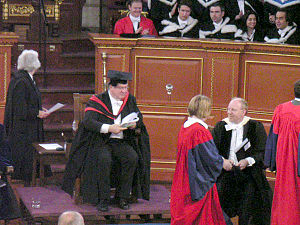A university is an institution of higher education and research, which grants academic degrees in a variety of subjects. A university provides both undergraduate education and postgraduate education. The word university is derived from the Latin universitas magistrorum et scholarium, roughly meaning "community of teachers and scholars."
News of All University of World wide
University:
Modern universities:

The end of the medieval period marked the beginning of the transformation of universities that would eventually result in the modern research university. Many external influences, such as eras of humanism, Enlightenment, Reformation, and Revolution, shaped research universities during their development.
By the 18th century, universities published their own research journals, and by the 19th century, the German and the French university models had arisen. The German, or Humboldtian model, was conceived by Wilhelm von Humboldt and based on Friedrich Schleiermacher’s liberal ideas pertaining to the importance of freedom, seminars, and laboratories in universities.The French university model involved strict discipline and control over every aspect of the university.
Until the 19th century, religion played a significant role in university curriculum; however, the role of religion in research universities decreased in the 19th century, and by the end of the 19th century, the German university model had spread around the world. Universities concentrated on science in the 19th and 20th centuries and become increasingly accessible to the masses. In Britain the move from industrial revolution to modernity saw the arrival of new civic universities with an emphasis on science andengineering. The British also established universities worldwide, and higher education became available to the masses not only in Europe. In a general sense, the basic structure and aims of universities have remained constant over the years.
The end of the medieval period marked the beginning of the transformation of universities that would eventually result in the modern research university. Many external influences, such as eras of humanism, Enlightenment, Reformation, and Revolution, shaped research universities during their development.
By the 18th century, universities published their own research journals, and by the 19th century, the German and the French university models had arisen. The German, or Humboldtian model, was conceived by Wilhelm von Humboldt and based on Friedrich Schleiermacher’s liberal ideas pertaining to the importance of freedom, seminars, and laboratories in universities.The French university model involved strict discipline and control over every aspect of the university.
Until the 19th century, religion played a significant role in university curriculum; however, the role of religion in research universities decreased in the 19th century, and by the end of the 19th century, the German university model had spread around the world. Universities concentrated on science in the 19th and 20th centuries and become increasingly accessible to the masses. In Britain the move from industrial revolution to modernity saw the arrival of new civic universities with an emphasis on science andengineering. The British also established universities worldwide, and higher education became available to the masses not only in Europe. In a general sense, the basic structure and aims of universities have remained constant over the years.
Universities around the world:
The funding and organization of universities varies widely between different countries around the world. In some countries universities are predominantly funded by the state, while in others funding may come from donors or from fees which students attending the university must pay. In some countries the vast majority of students attend university in their local town, while in other countries universities attract students from all over the world, and may provide university accommodation for their students.
Blog Archive
Blogger Template created by Deluxe Templates
Wordpress Theme designed by 7earn.blogspot.com

